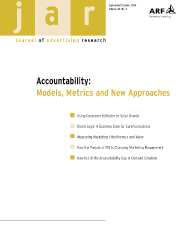Crossref Citations
This article has been cited by the following publications. This list is generated based on data provided by
Crossref.
Lievens, Filip
van Dam, Karen
and
Anderson, Neil
2002.
Recent trends and challenges in personnel selection.
Personnel Review,
Vol. 31,
Issue. 5,
p.
580.
Jahng, J J
Jain, H
and
Ramamurthy, K
2002.
Personality traits and effectiveness of presentation of product information in e-business systems.
European Journal of Information Systems,
Vol. 11,
Issue. 3,
p.
181.
LIEVENS, FILIP
and
HIGHHOUSE, SCOTT
2003.
THE RELATION OF INSTRUMENTAL and SYMBOLIC ATTRIBUTES TO A COMPANY'S ATTRACTIVENESS AS AN EMPLOYER.
Personnel Psychology,
Vol. 56,
Issue. 1,
p.
75.
Mowen, John C.
and
Harris, Eric G.
2003.
The MDPS method of message theme development: a new tool for managers.
Journal of Consumer Marketing,
Vol. 20,
Issue. 5,
p.
428.
Braunstein, Jessica R.
and
Zhang, James J.
2005.
Dimensions of athletic star power associated with Generation Y sports consumption.
International Journal of Sports Marketing and Sponsorship,
Vol. 6,
Issue. 4,
p.
37.
Lievens, Filip
Van Hoye, Greet
and
Schreurs, Bert
2005.
Examining the relationship between employer knowledge dimensions and organizational attractiveness: An application in a military context.
Journal of Occupational and Organizational Psychology,
Vol. 78,
Issue. 4,
p.
553.
Chang, Pao‐Long
and
Chieng, Ming‐Hua
2006.
Building consumer–brand relationship: A cross‐cultural experiential view.
Psychology & Marketing,
Vol. 23,
Issue. 11,
p.
927.
2006.
Markenstärkemessung unter besonderer Berücksichtigung von Konsumentenheterogenität.
p.
289.
Okazaki, Shintaro
2006.
Excitement or sophistication? A preliminary exploration of online brand personality.
International Marketing Review,
Vol. 23,
Issue. 3,
p.
279.
James, David O.
Lyman, Madge
and
Foreman, Susan K.
2006.
Does the tail wag the dog? Brand personality in brand alliance evaluation.
Journal of Product & Brand Management,
Vol. 15,
Issue. 3,
p.
173.
Wu, Shwu-Ing
2006.
A comparison of the behavior of different customer clusters towards Internet bookstores.
Information & Management,
Vol. 43,
Issue. 8,
p.
986.
Wu, Shwu‐Ing
2007.
The influence of personal character on information communication and activity effect.
Marketing Intelligence & Planning,
Vol. 25,
Issue. 7,
p.
746.
Lau, Kong Cheen
and
Phau, Ian
2007.
Extending symbolic brands using their personality: Examining antecedents and implications towards brand image fit and brand dilution.
Psychology & Marketing,
Vol. 24,
Issue. 5,
p.
421.
Smit, Edith
Bronner, Fred
and
Tolboom, Maarten
2007.
Brand relationship quality and its value for personal contact.
Journal of Business Research,
Vol. 60,
Issue. 6,
p.
627.
Hall, Mark C.
2008.
The Marketing of Organic Products: An Instrumental/Symbolic Perspective.
Journal of Food Products Marketing,
Vol. 14,
Issue. 3,
p.
1.
홍종필
2008.
Conceptual investigation of the image construct in advertising, marketing and consumer research.
The Korean Journal of Consumer and Advertising Psychology,
Vol. 9,
Issue. 1,
p.
127.
Geuens, Maggie
Weijters, Bert
and
De Wulf, Kristof
2009.
A new measure of brand personality.
International Journal of Research in Marketing,
Vol. 26,
Issue. 2,
p.
97.
Raghavan, Srividya
and
Balaji, M. S.
2009.
Communicating Brand Personality - The Moderating Role of Human Personality.
SSRN Electronic Journal,
Sung, Yongjun
Kim, Jooyoung
and
Jung, Jong-Hyuok
2009.
The Predictive Roles of Brand Personality on Brand Trust and Brand Affect: A Study of Korean Consumers.
Journal of International Consumer Marketing,
Vol. 22,
Issue. 1,
p.
5.
Bian, Xuemei
and
Moutinho, Luiz
2009.
An investigation of determinants of counterfeit purchase consideration.
Journal of Business Research,
Vol. 62,
Issue. 3,
p.
368.


